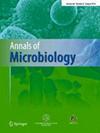Revealing the microbial composition changes and relationship with Fusarium caused by rot disease in the Crocus sativus L.
IF 3.4
4区 生物学
Q2 BIOTECHNOLOGY & APPLIED MICROBIOLOGY
引用次数: 0
Abstract
Rot disease caused by Fusarium poses a formidable threat to the growth of saffron (Crocus sativus L.), resulting in substantial damage to both yield and quality. It is paramount to delve into the root causes of rot disease in saffron to optimize both yield and quality. Existing preventive and treatment modalities have exerted deleterious effects on corms and the natural environment. Consequently, the quest for efficacious and eco-friendly methods such as biological control agents has become an urgent imperative. The disparate distribution of microbial communities between rhizospheric microorganisms and saffron serves as the foundational exploration for uncovering the underlying causes of rot disease. Samples from various saffron organs and rhizosphere soil were gathered, and the sequencing data from the microbial communities were interpreted using 16S rRNA and ITS gene sequencing methods. This facilitated an in-depth examination of the composition and changes of microorganisms in both healthy and diseased saffron plants. The findings indicated rot disease reduced the abundance and diversity of microorganisms in saffron, and the fungal co-occurrence networks were less stable and their communities were more sensitive to rot disease than the bacterial community. Fusarium was the predominant genus in diseased samples, accounting for 99.19% and 89.77% of the communities in diseased leaves and corms. With corms and leaves displaying heightened susceptibility to infection compared to other plant organs. Some of the beneficial bacterial taxa enriched in the diseased plants were also identified in networks, they showed an antagonistic relationship with Fusarium, suggesting a potential for these bacteria to be used in biologically based control strategies against rot disease. These insights could prove invaluable for the development of biocontrol agents aimed at combating this plant ailment. These findings significantly advance our understanding of saffron-microbiome interactions and could provide fundamental and important data for improving saffron yield and quality in the process of sustainable development.揭示番石榴腐烂病微生物组成的变化及其与镰刀菌的关系
由镰刀菌引起的腐烂病对藏红花(Crocus sativus L.)的生长构成了巨大威胁,对产量和质量都造成了严重损害。要优化产量和质量,就必须深入研究藏红花腐烂病的根本原因。现有的预防和治疗方法对球茎和自然环境造成了有害影响。因此,寻求生物防治剂等有效且环保的方法已成为当务之急。根瘤微生物和藏红花之间微生物群落分布的差异是揭示腐烂病根本原因的基础性探索。研究人员收集了来自不同藏红花器官和根瘤土壤的样本,并使用 16S rRNA 和 ITS 基因测序方法解读了微生物群落的测序数据。这有助于深入研究健康和患病藏红花植株中微生物的组成和变化。研究结果表明,腐烂病降低了藏红花中微生物的丰度和多样性,与细菌群落相比,真菌共生网络的稳定性较差,其群落对腐烂病更为敏感。镰刀菌是染病样本中的主要菌属,分别占染病叶片和球茎群落的 99.19% 和 89.77%。与其他植物器官相比,茎秆和叶片更容易受到感染。病株中富集的一些有益细菌类群也在网络中被发现,它们与镰刀菌之间存在拮抗关系,这表明这些细菌有可能被用于以生物为基础的腐烂病防治策略中。这些见解对于开发旨在防治这种植物病害的生物控制剂来说可能是非常有价值的。这些发现极大地推动了我们对藏红花-微生物组相互作用的理解,并为在可持续发展过程中提高藏红花的产量和质量提供了重要的基础数据。
本文章由计算机程序翻译,如有差异,请以英文原文为准。
求助全文
约1分钟内获得全文
求助全文
来源期刊

Annals of Microbiology
生物-生物工程与应用微生物
CiteScore
6.40
自引率
0.00%
发文量
41
审稿时长
3.2 months
期刊介绍:
Annals of Microbiology covers these fields of fundamental and applied microbiology:
general, environmental, food, agricultural, industrial, ecology, soil, water, air and biodeterioration.
The journal’s scope does not include medical microbiology or phytopathological microbiology.
Papers reporting work on bacteria, fungi, microalgae, and bacteriophages are welcome.
Annals of Microbiology publishes Review Articles, Original Articles, Short Communications, and Editorials.
Originally founded as Annali Di Microbiologia Ed Enzimologia in 1940, Annals of Microbiology is an official journal of the University of Milan.
 求助内容:
求助内容: 应助结果提醒方式:
应助结果提醒方式:


